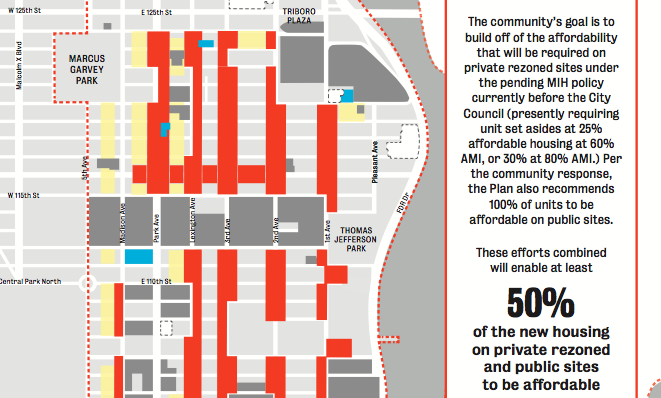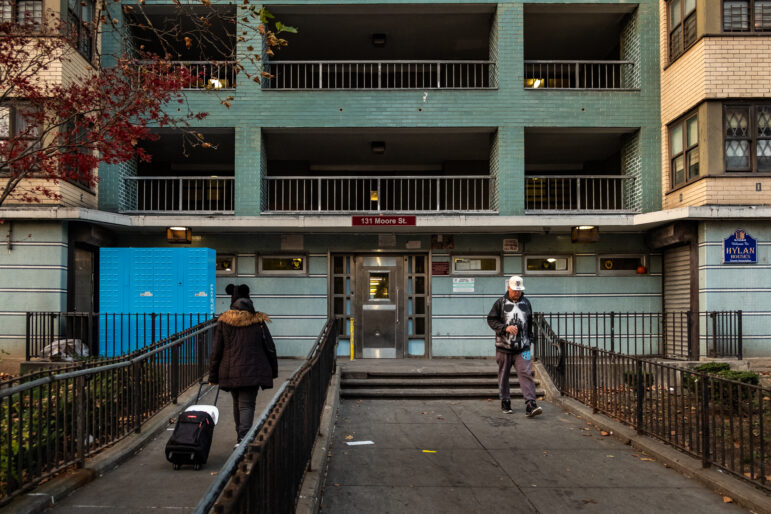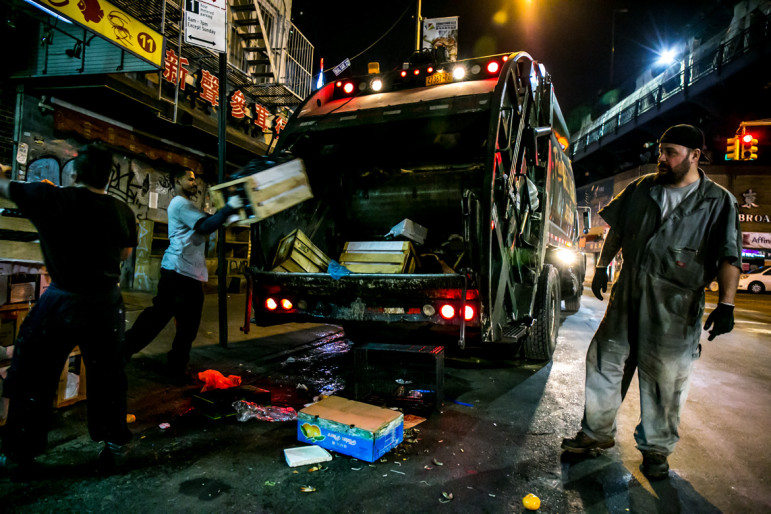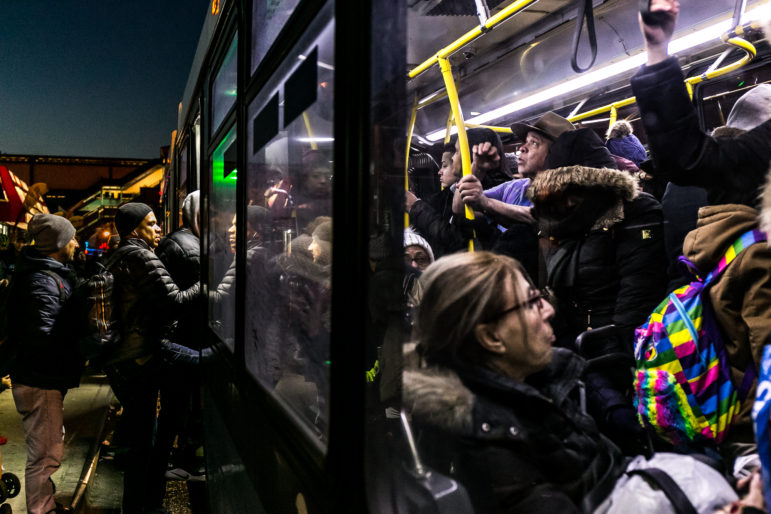
From the East Harlem Neighborhood Plan
As protesters stormed the stage at a meeting of Manhattan’s Community Board 11 last night after hours of public comment, the board voted against a plan to upzone major avenues in East Harlem unless the Department of City Planning adopts the recommendations made by the board’s rezoning task force. But some board members questioned the process that lead to the vote and the final tally’s validity.
A full version of the task force’s recommendations can be viewed here and a condensed version here. Those recommendations in many ways lent support to, and in some ways built upon, the East Harlem Neighborhood Plan, the proposal created by a community coalition led by local councilwoman and City Council Speaker Melissa Mark-Viverito that included a rezoning for the area.
DCP’s proposal, which covers the area roughly between East 104th Street to East 132nd, and from Second Avenue to Park Avenue, did take into account some of the demands of the East Harlem Neighborhood Plan, but the board’s rezoning task force’s position was that the city’s plan does not fully enough absorb the East Harlem Neighborhood Plan’s zoning recommendations, as well as other points included in the neighborhood plan. Last Friday, the board’s Land Use Committee voted against the rezoning unless the city adopted the rezoning task force’s recommendations.
Critics of the board, however, thought the vote should have been a straight no. When during the public comment period Alba Campuzano, an East Harlem resident said in Spanish translated to English: “We want 30 percent of new housing to be built for us,” others shouted back “too low!”
That was the position of many who chanted in protest and disrupted the vote Tuesday night as hundreds gathered in a large auditorium at the Icahn School of Medicine at Mount Sinai. One after another spoke out against the plan, which was called a “luxury housing plan,” a “payday for slumlords,” and a “scam racist proposal,” among other things. People held signs reading “East Harlem is not for Sale” and “Stop Racist Rezoning” and pleaded with board members to vote no, expressing fears that the plan would ultimately displace them.
The city determined during its legally mandated environmental review that the rezoning would not result in significant displacement because of rising rents, but does expect the rezoning to directly displace residents of 11 apartments in two buildings and 14 businesses.
Marina Ortiz, who also spoke at Tuesday’s meeting, called the city’s numbers “a straight-up lie.”
Many who demanded the board vote no with no conditions said the task force recommendations didn’t go far enough to ward of gentrification.
The recommendations include 100 percent affordable housing on city-owned sites, a program to prevent displacement of rent-stabilized tenants, and a request that density be increased just enough for the area to fall under the mandatory inclusionary housing policy, under which 20-30 percent of developments are kept “affordable”. (The task force, however, wants that percentage raised to 50 percent affordability on private land, with 20 percent reserved for families of three making no more than $25,770 and the remaining 30 percent reserved for middle-income families making up to $103,080.)
Among the East Harlem residents who have rejected outright the idea of the rezoning since its inception are members of Movement for Justice in El Barrio, which has adopted its own ten-point plan. The points include improved outreach to inform tenants of their rights and better enforcement of the housing code. In emails over the weekend, some of these stakeholders expressed consternation that not all the points were incorporated into the task force recommendations, and they reiterated their opposition to any rezoning.
Prior to the vote, some of the board members sent emails expressing dissatisfaction with the fact that they didn’t receive a copy of the task force recommendations until two-and-a-half hours before the meeting and had little time to review them. The written copy of those recommendations that are linked above, while read aloud at the Land Use Committee last Friday, are still not available to the public through the board’s website (they were obtained through a board member by City Limits).
As the board chair tried to hold the vote on the motion to vote down the proposal unless the task force resolutions were adopted, people from the audience took over the stage where board members sat, chanting “no conditions,” remaining there for about 15 minutes, holding signs and banners, making it difficult to take the vote. It was eventually taken by tally on a piece of paper even though some board members had already left their seats.
The final vote was 31-7, with one abstention, Chair Diane Collier told City Limits during the close of the meeting (the board’s office staff were unable to confirm this on Wednesday morning, but it was unclear why).
However, there seemed to be confusion among board members as to whether voting the motion down would amount to voting yes to the rezoning, with no conditions at all.
Jarquay Abdullah abstained because of that issue.
“I had to because either you vote yes, you’re agreeing to the no with…conditions. If you vote no, you’re agreeing to the rezoning,” he said, adding “I want to vote no with no conditions.”
“Did I even vote? I can’t recognize whatever I did,” said board member Mahfuzur Rahman, explaining that he believed the circumstances under which the vote was taken invalidated it. Even so, he voted “no” on the motion because he wanted the rezoning task force’s conditions, as well as a requirement for the city to commit to them, included in the language.
Candy Vives-Vasquez, Land Use, Landmarks & Planning chair, said the chaos in the room meant no explanation of the motion could be heard over the shouting and that led to confusion.
“They don’t understand we’re saying no because it’s not conforming to the community’s vision,” she said.
The board did not vote Tuesday on a related proposal of whether to bring 100 percent rent-restricted development to the 111th Street Ballfield site, since the meeting was adjourned following the zoning vote after things got so contentious that a hospital staff member and police officers tried to help calm things down.
Borough President Gale Brewer will likely hold a hearing on the rezoning on July 13, 6:30 pm at the Silberman School of Social Work, 2180 3rd Avenue, New York, NY 10035.









4 thoughts on “Amidst Protests and Questions about Process, East Harlem Board Takes Vote on Rezoning”
What the Chairperson of CB11 and the Chairperson of the Land Use Committee and the Chairperson of the Rezoning Task Force did last night was contrary to Roberts Rules of Order in the way these three prevented a “Substitute Motion” of a straight “NO” vote (“with no considerations”) which the CB11 leadership effectively prevented to be discussed and voted on to circumvent the debacle of a “NO vote with consideration” which was designed by the CB11 leadership to basically appease the downtown real estate interest as a watered down “yes” vote. The confusion created with the “No, with consideration” was unacceptable to voting members of CB11 and the General Public. That could have been handled better by following proper procedures for dialogue with an allowance for a “Substitute Motion” and rolling the dice with a procedural vote on the issue to settle the matter fair and square. But No, the CB11 Leadership stated that the Substitute Motion can only be discussed as “New Business” after the “No with consideration” motion was voted on. Which is incorrect. This is absolutely unfair for the CB11 Leadership to do and the enraged public demanded a redress which of course Mrs. Diane Collier, Candy Vives and LeShawn Henry prevented with their capricious improper leadership. Let’s visit the legality of their actions, and open the radio waves for community comment. Robert’s Rules of Order – A Quick Guide to Motions and Voting Motions are statements that describe a proposed action or decision. Although the formality of Robert’s Rules can seem cumbersome, the process of making motions ensures that no decision is accepted without the opportunity for discussion and a vote. Typically the motion making process progresses as follows: A member of the group proposes a motion: “I move that…” • Motions require that a second member of the group agrees to consider the proposal to ensure that the proposal is meaningful to more than one person. A member of the group chooses to second: “I second” or “I second for discussion” if you want to be clear that you are not in support but want to entertain a conversation about the proposal. • Without a second the motion will die. Once the group has had a chance to speak in favor or against the motion, the Chairman will lead a vote. Types of Motions Main motion – A motion must be made and seconded to initiate discussion on an issue (a limited amount of discussion may be allowed at the discretion of the Chairman prior to a motion being made). Motions are projected onto a screen for all to see before being voted on. Substitute motion – Used to propose an alternative action to the main motion. Up to one main and two substitute motions may be on the floor at one time. If a substitute motion passes, it does away with the prior motions. If it fails, the previous motion comes back up for consideration. In other deliberative assemblies, using Robert’s Rules of Order, a substitute amendment is a form of the motion to amend. It could be debated, modified, and voted on like other amendments. A substitute can be a sentence, paragraph, section, or article within a motion or resolution, or it can be the entire motion or resolution. It could be used to improve a poorly worded motion or resolution which helps to pass it. Procedure When a substitute is proposed, both the substitute and the wording of the motion that is being substituted for are considered.[5] In this case, the substitute could be amended and the original motion could be amended. Then a vote is taken on whether to put the substitute (with any modifications) in place of the original motion (with any modifications). This makes it fair for the proponents of the original motion (if only the substitute could be considered and passed, then the proponents of the original motion wouldn’t get a chance to advocate and possibly improve their motion if that was the case). If the substitute amendment passed, the main motion as amended would still need to be voted on. Robert, Henry M.; et al. (2011). Robert’s Rules of Order Newly Revised (11th ed.). Philadelphia, PA: Da Capo Press. p. 157. ISBN 978-0-306-82020-5.
It is quite common for leadership on community boards to circumvent the law, when a vote is not in favor of a political position that is being pushed. Community Boards are allowed to violate these laws, because their votes are viewed a advisory only, but these votes do have a political impact!
There is a major difference in a No and a No with Conditions! The Boards chairs knows this that is why they push for the second. The second vote gives the rest of the agencies that must review this process wiggle room to make some minor changes and then push it forward for a vote, stating that they did make the conditions.
This scenario is now being played out all over NYC in community boards of color. For example, in Crown Heights, the Bedford Union Armory, which is almost an entire City Block is being sold for $1. The Land use committee voted a straight no and really did nothing to look deeply into this proposal to even consider alternative “conditions”. But now the Chairperson of the Board is trying to get the entire board to vote No with Conditions!
As far as the law is concern, the courts who are elected and pushed by the local political structure allows Community Boards to violate the law, to ensure that what the political structure wants they get!
With the Borough President being the sole person who can appoint and reappoint board members, this practice ensures that these members especially the leadership does whatever they want as long as they follow the script of the politicians when serious votes are done.
Often times the leadership actually benefits in a host of other ways, thus enforcing their behavior to not represent the interest of the community, but their own interest, which at times is political and financial.
There needs to be a serious revamping of community boards to not only empower them but to make them accountable to the people!
Pingback: Bear River Band of Rohnerville Rancheria Recruitment 2017 – Loleta, CA |Application Guides & Forms - fastgist.com.ng
Pingback: – A Confusing ‘No’ Vote on East Harlem Rezoning